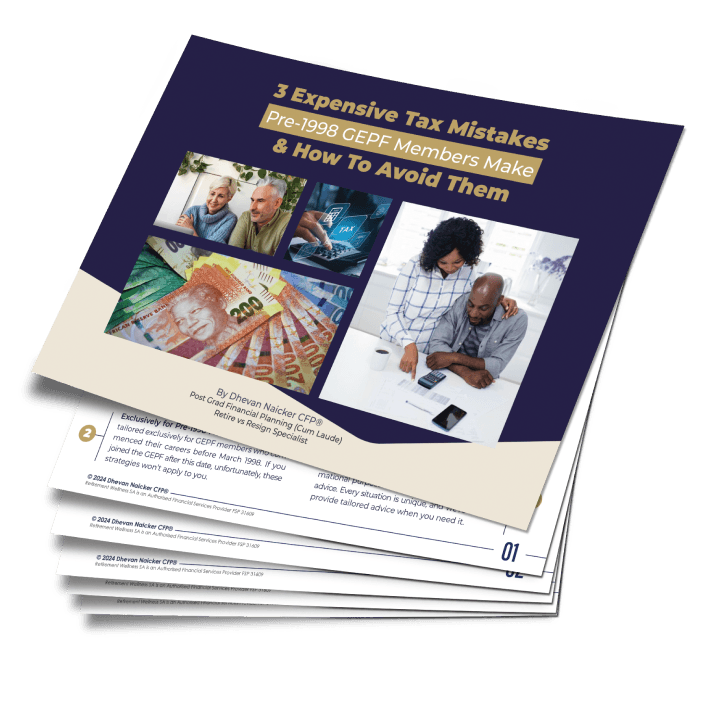As a government employee, you’ve worked hard for years, navigating a system that often feels stacked against you when it comes to taxes and retirement planning. But what if there’s a way to turn the tide? What if you could save thousands—if not tens of thousands—on taxes every year, just like Amanda, whose story demonstrates how the right financial strategies can lead to extraordinary results?
In this blog, we’ll walk through Amanda’s remarkable transformation and uncover key steps government employees can take to save on tax each year. Whether you’re considering early retirement, resignation, or simply want to make the most of your current financial situation, these insights could change your life.
Amanda’s Journey: From Tax Burden to Tax Refund
Amanda was a dedicated government employee and a mother of three. Despite her best efforts to manage her finances, she was paying an additional R40,000 in taxes each year due to income from her late husband. Her investments and policies weren’t aligned, and there was no clear plan for her financial future.
That’s when Amanda discovered the Retire vs Resign Masterclasses and decided to take control of her finances. After booking a VIP consultation, I crafted a personalized Resignation Success Plan tailored to her unique situation.
The results were incredible:
- Amanda received an unexpected R35,000 tax refund this year.
- In just five months, she recovered the cost of my services.
- Her money is now growing consistently, and her family’s legacy is secure.
Let’s break down the strategies that helped Amanda—and can help you—save on taxes every year.
Step 1: Understand the Impact of Tax on Your Income
For many government employees, taxes are a significant financial burden, especially when additional income sources like a spouse’s pension or investments are involved. Without proper planning, this can push you into higher tax brackets, leaving you with less disposable income.
Key Insight: Tax planning isn’t just about the amount you pay—it’s about managing when and how you pay it.
- If you’re earning income from multiple sources, analyze how this affects your overall tax liability.
- Work with a financial planner to identify opportunities for tax relief, such as restructuring your income streams.
In Amanda’s case, her late husband’s income had pushed her into a higher tax bracket. By restructuring her finances, we reduced her taxable income, ultimately saving her R35,000.
Step 2: Optimize Your Resignation or Retirement Plan
If you’re considering resignation or retirement, planning your tax strategy is essential. Here’s why:
- Resigning allows you to access your full pension value, which can be strategically reinvested to minimize taxes.
- Retiring typically comes with fixed payouts and compulsory tax deductions, which may not be as flexible.
For example, Amanda was able to resign and reinvest her lump sum strategically, saving on taxes while ensuring her money continued to grow. By comparing the tax implications of resignation vs. retirement, you can choose the option that works best for your financial goals.
Step 3: Take Advantage of Tax-Free Thresholds
One of the biggest opportunities for tax savings lies in understanding and leveraging tax-free thresholds. For government employees, this can include:
- Pre-1998 tax-free benefits: If part of your pension falls under this category, it’s not taxable.
- Tax-free savings accounts: Maximize your contributions to reduce taxable income while growing your wealth.
Amanda’s plan included taking full advantage of these thresholds, ensuring she paid the least amount of tax possible while keeping more of her money for herself and her family.
Step 4: Align Your Investments and Policies
Disorganized investments can lead to inefficiencies and unnecessary tax liabilities. Amanda’s investments weren’t working together, which led to missed opportunities for growth and increased tax burdens.
To address this:
- Consolidate and align your investments to reduce redundancies.
- Choose tax-efficient investment vehicles, such as retirement annuities or tax-free savings accounts.
- Set clear financial goals to ensure every investment contributes to your long-term success.
By restructuring Amanda’s policies, we eliminated overlap, optimized growth potential, and reduced her tax burden significantly.
Step 5: Plan for the Long Term
Effective tax planning isn’t just about the present—it’s about securing your financial future. Here’s how you can plan ahead:
- Create a legacy plan: Ensure your children or dependents inherit your wealth without facing excessive taxes.
- Factor in medical aid and leave payouts: Understand how these affect your taxable income when you retire or resign.
- Review your plan regularly: Tax laws change, and your plan should adapt to ensure ongoing savings.
For Amanda, the peace of mind came from knowing her daughters would inherit her hard-earned money in a tax-efficient manner, ensuring their future security.
The Results Speak for Themselves
Amanda’s journey demonstrates the power of personalized financial planning:
- She saved R70,000 in one year through a combination of tax refunds and avoided liabilities.
- Her resignation plan ensured her money was ready even before she left her job, eliminating financial stress.
- She now has a clear plan for her investments, taxes, and legacy, giving her the confidence to focus on what matters most—her family.
Take Control of Your Financial Future
If Amanda’s story resonates with you, it’s time to take action. Whether you’re facing high taxes, considering resignation, or simply want to make the most of your finances, the strategies outlined above can help you achieve your goals.
To learn more, sign up for the Retire vs Resign Masterclass (www.retirevsresign.co.za) and book your VIP consultation (www.retirevsresign.co.za/consult) today. Together, we can create a plan that saves you money, grows your wealth, and secures your family’s future.
Disclaimers:
Retirement Wellness SA is an Authorised Financial Services Provider – FSP 31609. This blog provides information, not advice.
This information is not provided by or on behalf of the Government Employees Pension Fund (GEPF). We do not act on behalf of the GEPF.

